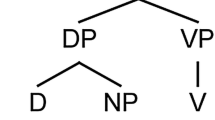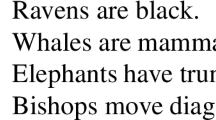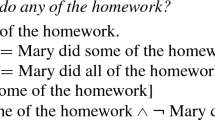Abstract
This paper is concerned with the semantics of bare plural I-generics such as ‘Tigers are striped’, ‘Chickens lay eggs’, and ‘Kangaroos live in Australia’. In a series of recent papers, Bernhard Nickel has developed a comprehensive view of a certain class of bare plural I-generics, which he calls characterizing sentences (Nickel in Linguist Philos 31(6):629–648, 2009. doi:10.1007/s10988-008-9049-7; Linguist Philos 33(6):479–512, 2010a. doi:10.1007/s10988-011-9087-4; Philos Impr 10(6):1–25, 2010b). Nickel’s ambitious proposal includes a detailed account of their truth-conditions, an account of certain pragmatic phenomena that they give rise to, a metaphysical picture of their truth-makers in terms of mechanisms, and an epistemological story connecting characterizing sentences to such concepts as induction and explanation. This paper offers an extended critique of the central truth-conditional component of Nickel’s proposal. In a nutshell, his account has it that ‘Tigers are striped’ is true iff, for tigers, there is a way of being normal with respect to fur-pattern such that all tigers that are normal that way are striped. I begin by explaining what characterizing sentences are and distinguish several readings that are available for sentences with bare plurals in subject position. I then introduce Nickel’s account and discuss some of its predictions which, in my view, seem highly problematic. Moreover, I argue that Nickel’s principle of Homogeneity does not go together well with his proposed truth-conditions, and that his truth-conditional account violates a plausible principle about the logic of generics, a principle I call generic non-contradiction.
Similar content being viewed by others
References
Carlson, G. N. (1977). Reference to kinds in English. Doctoral Dissertation, University of Massachusetts.
Cohen, A. (1999). Think generic! The meaning and use of generic sentences. Stanford, California: CSLI (Dissertations in linguistics).
Cohen, A. (2004a). Existential generics. Linguistics and Philosophy, 27(2), 137–168. doi:10.1023/B:LING.0000016441.89129.3d.
Cohen, A. (2004b). Generics and mental representations. Linguistics and Philosophy, 27(5), 529–556. doi:10.1023/B:LING.0000033851.25870.3e.
Heycock, C., & Zamparelli, R. (2005). Friends and colleagues. Plurality, coordination, and the structure of DP. Natural Language Semantics, 13, 201–270.
Hoeksema, J. (1988). The semantics of non-boolean ‘And’. Journal of Semantics, 6, 19–40.
Kratzer, A. (1995). Stage-level and individual-level predicates. In G. N. Carlson & F. J. Pelletier (Eds.), The generic book (pp. 125–175). Chicago: University of Chicago Press.
Krifka, M. (1987). An outline of genericity, partly in collaboration with Claudia Gerstner. SNS-Bericht 87-23, University of Tübingen.
Krifka, M. (1990). Boolean and non-boolean ‘and’. In L. Kálmán & L. Pólos (Eds.), Papers from the second symposium on logic and language (pp. 161–188). Budapest: Akadémiai Kiadó.
Krifka, M. (2003) Bare NPs. Kind-referring, indefinites, both, or neither? In SALT 13 (p. 180). doi:10.3765/salt.v13i0.2880.
Krifka, M., Pelletier, F. J., Carlson, G. N., ter Meulen, A., Link, J., & Chierchia, G. (1995). Genericity: An introduction. In G. N. Carlson & F. J. Pelletier (Eds.), The generic book (pp. 1–24). Chicago: University of Chicago Press.
Lasersohn, P. (1995). Plurality, conjunction, and events. Dordrecht, Boston: Kluwer.
Leslie, S.-J. (2008). Generics: Cognition and acquisition. Philosophical Review, 117(1), 1–47. doi:10.1215/00318108-2007-023.
Nickel, B. (2009). Generics and the ways of normality. Linguistics and Philosophy, 31(6), 629–648. doi:10.1007/s10988-008-9049-7.
Nickel, B. (2010a). Generically free choice. Linguistics and Philosophy, 33(6), 479–512. doi:10.1007/s10988-011-9087-4.
Nickel, B. (2010b). Ceteris Paribus laws: Generics & natural kinds. Philosophers’ Imprint, 10(6), 1–25.
Sterken, R. K. (2015). Leslie on generics. Philosophical Studies, 172(9), 2493–2512. doi:10.1007/s11098-014-0429-2.
von Fintel, K. (1997). Bare plurals, bare conditionals, and only. Journal of Semantics, 14(1), 1–56.
Author information
Authors and Affiliations
Corresponding author
Rights and permissions
About this article
Cite this article
Hoeltje, M. Generics and ways of being normal. Linguist and Philos 40, 101–118 (2017). https://doi.org/10.1007/s10988-016-9203-6
Published:
Issue Date:
DOI: https://doi.org/10.1007/s10988-016-9203-6




